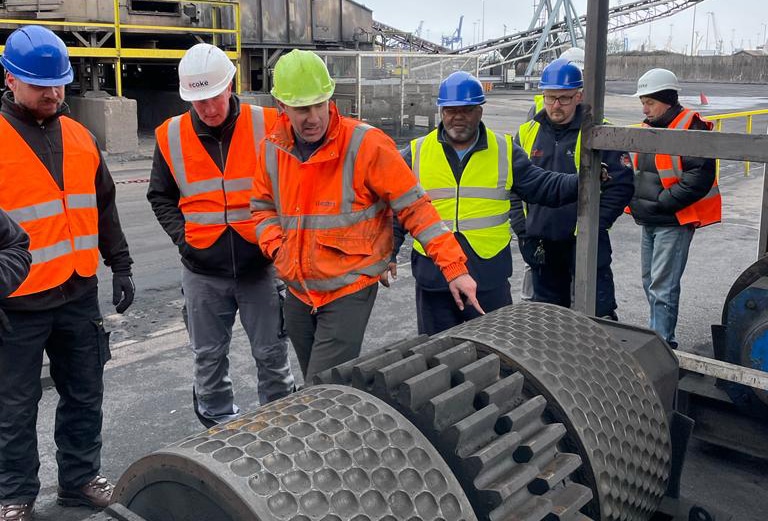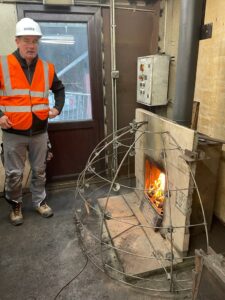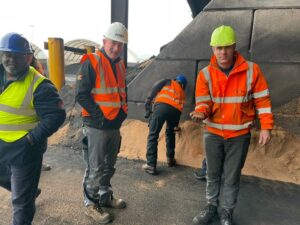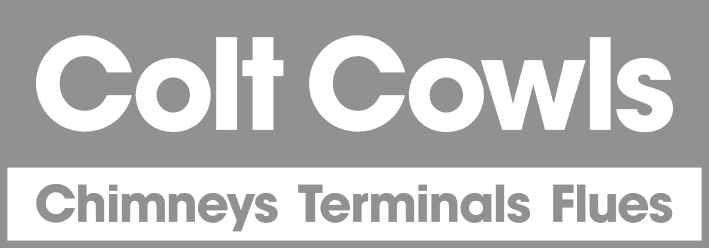Winding through the north Lincolnshire countryside towards the CPL Briquetting Works, you know you are getting close as the chimneys and steam of the Humber Refinery appear on the horizon. Leaving the refinery and the faint but not unpleasant sulphur odour behind, a few minutes more and you enter the extensive industrial landscape of the Immingham dock area.
A few weeks ago a group of intrepid Guild members gathered on a cold grey morning for a tour of the CPL smokeless fuel briquetting works. It might not sound like a fun day out to everyone, but these members had won a place on this trip in a recent prize draw and were keen to learn more.
Works manager Neil Rowbotham beckoned us in with a welcome hot drink and explained the itinerary. He gave a really informative presentation which explained the basics of the different processes and outlined what we’d be seeing on the tour. The questions began almost immediately. A box containing all the CPL products was passed round. Each briquette is a different size and shape, and this identifies the product e.g. Stoveheat, Ecoal, Phurnacite. Everyone was particularly interested in a dark brown speckled looking oval. This turned out to be a developmental fuel – a 100% biomass smokeless briquette. The light speckled parts were ground olive stones. All very interesting to a curious sweep. It’s not on the market yet though, and Neil spoke of the challenges in scaling up production of all new products.
The group were engrossed in the presentation and questions when Neil called a halt and led us out to the works. Hard hats, hi-vis and suitable footwear are the order of the day along with every bit of extra clothing we could find.
A few flakes of particularly white looking snow drifted straight off the north sea, although it felt more like the Baltic. However, nothing could dampen the enthusiasm of the group and a brisk walk across the wet and very black yard led us to the machinery of smokeless fuel manufacture.
Neil had described the ingredients and mixing process as much like making a cake. They have a recipe with ingredients and a method. You’d imagine that with a strictly managed industrial manufacturing process, it would be a case of mixing the ingredients in one end, and getting your product out the other. Well, not really. Due to all the naturally occurring variables in the raw materials, constant monitoring of a variety of product contents and characteristics is required to maintain a consistent result.

We gathered at the point where the briquette powder mix entered the moulding machines. Dust went in on a fast moving conveyor and the rotating moulds, or ‘tyres’ threw out the familiar shape of a smokeless briquette. It’s strangely satisfying to watch it all happen.
Neil removed some freshly pressed briquettes for us to examine. Taking one each, we found they could be easily crushed at this stage. They also had a faint smell of the resin used as a binder for this product. The production line here runs at a much lower temperature that the ‘hot’ plant that uses molasses as the binding agent. Our briquettes now moved very slowly along a wide conveyor to allow them to harden a bit before further handling. Looking through the open area past the machinery, we could see a loader feeding a conveyor system that was loading coals made an hour or so earlier onto a lorry. There was another lorry waiting. They produce 365 days a year. Neil told us that throughout the challenges of covid, they only lost 2 days production.
Further down the line we encountered the testing room. It was a welcome break from the cold as this is where an open fire, a stove and a solid fuel boiler are all running as part of the continuous testing process. Fuels are tested on these appliances with calibrated loads being refuelled at precise intervals. All the results are continuously monitored and recorded to ensure a consistent product.

There is a dedicated ‘lab’ area of the site which mixes and makes small runs of developmental products. New fuels all make their way to the fires in testing room where the results can be compared to previous standard data.

The ‘tyre’ storage area held all the different mould patterns used for different products. They are nice looking objects. Large, solid, expensive and made in the UK. Onwards, and now up some ladders. We had a great view of the CPL works and the massive stockpiles of petcoke in a neighbouring rival manufacturers yard. Neil said this was ‘waste’ from an American refiner who used it for their briquette operation in the UK. There in the distance was the Humber Refinery again.
We made our way back to the office with Neil fielding questions and pointing out areas of interest. A very nice buffet lunch and several cups of tea was just the ticket, before yet more questions. Neil said later he’s always enjoyed the visits from sweeps as they are genuinely interested in the whole process. Our questions certainly revealed the depth of Neil’s knowledge as he answered all the queries with ease, often adding extra interesting information. One question did occur to me, how many individual briquettes are made in a year? Neil got back later with the answer, and you can have a guess in our competition on page of the magazine.
For me, it was interesting to return to the works after arranging a visit there by the first ever group of sweeps in 2014. One thing that struck me was how much some of the fuels have changed, and further changes are coming. Much of this was new to me. This sort of knowledge reflects very well on the sweep when discussing fuels with our customers and publishing information to our websites and social media. So if it’s new information to me, there are probably lots of others who could benefit from an update. With this in mind, I am trying to arrange a live webinar presentation followed by Q & A (always the best bit). As in the past, we can record it and place it on the website etc. Given what we learned on the day, I’m sure that over time this will make a difference to sweeps overall knowledge of these fuels.
Speaking with Jon Carter on the journey home, he generously offered to make this visit an annual fixture in the calendar. So if you missed out this time round, there’s always next year’s draw.
CPL (Homefire Group) are exhibiting at the Sweep Stuff ’23 trade exhibition and it’s a great opportunity to learn more.
Thank you very much to Jon Carter and Neil Rowbotham for organising and making us so welcome.

















